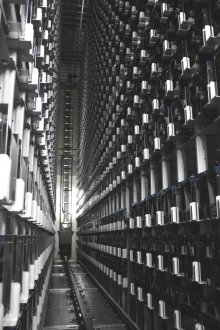
The first columbarium in the Chubu region to use an automated cinerary box conveyor system opened last month in Nagoya as the popularity of tombs that do not require much maintenance grows.
In Tokyo, the number of such columbaria, where many sets of remains can be housed in one place, is rising due to a shortage of burial grounds. Toyota Industries Corp., which developed the system, says this method of storing the ashes of the dead will spread in rural areas as well as Japan’s birthrate dips and its elderly population expands.
Toyota Industries holds 70 percent of the domestic market for the conveyor system, a technology that was originally developed for distribution warehouses.
Saishoden, a four-story columbarium that opened in Nagoya’s Atsuta Ward at the end of July, has about 1,900 sq. meters of floor space.
When a visitor places an IC card on top of the reader at the reception desk and goes to the specified prayer booth, the system will start transporting the box with the cremated ashes. In about 40 seconds, a tombstone engraved with the name of the deceased will appear in the booth.
Flowers and sets of incense tools are provided so visitors do not have to bring anything with them. They also do not have to worry about the weather because the booths are indoors.
The first 600 units, each of which can store the remains of up to eight people, were put on sale at a discounted price of ¥700,000.
The facility has a capacity to accommodate 5,500 units with 15 prayer booths for visitors. Behind the booths, the cinerary boxes are stored compactly in shelves 7 meters high and 25 meters deep, and the three machines keep moving back and forth to carry the urns to the booths as soon as they read the data from the IC cards, making use of the warehousing technology to sort them efficiently.
The company began selling the system in 2009. Toyota Industries’ product is used in 13 of the roughly 20 columbaria nationwide that run on automated conveyor systems, mainly in metropolitan areas. Three others are under construction, in Tokyo and Chiba Prefecture.
The system was highly regarded for withstanding the Great East Japan Earthquake and for its detailed management mechanism. Its popularity spread among temple workers by word of mouth.
A burial site and tombstone would typically cost around ¥2 million in the Chubu region. In addition, relatives of the deceased would have to clean and maintain the grave.
However, people who moved away from hometowns for work are growing older and having difficulty visiting graves, leading to a rising number of untended graves in rural areas.
“Because of the declining birthrate and aging population, the burden of maintaining a grave is becoming heavier than ever,” said Tetsuya Takahashi, group manager of Toyota Industries’ distribution engineering department in charge of the conveyor system.
“It’s likely that columbaria with an automated conveyor system will become more popular not just in big cities, but in midsize cities in regional areas too,” he predicted.
Shorakuji Temple in Shinshiro, Aichi Prefecture, which manages Saishoden, decided to open the facility in Nagoya as it predicts there will be growing demand for city-dwellers to visit deceased relatives in the city as there is no one left to do so in the countryside.
“It is becoming more difficult for people living in the city to hold memorial services for their ancestors, so I hope people will use the latest technology to obtain a place to pray for their deceased relatives and find emotional support,” said Taijun Sato, the chief priest.


